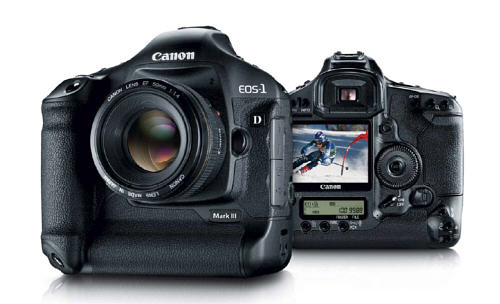
Me want

>
This impressive specs of the Mark III include a massive 21.1 megapixel CMOS Sensor and the ability to capture up to 5 frames per second (fps), along with a dual DIGIC III Image Processor, EOS Integrated Cleaning System and a 3.0" fine detail LCD Screen.
Superseding the 16.7 megapixel EOS-1Ds Mark II, the Mark III features a 36 x 24 mm CMOS image sensor that is comprised of approximately 21.1 million effective pixels (5632 x 3750) and set at a pitch of 6.4 microns. This ultra-high resolution was developed by Canon specifically for the EOS-1Ds Mark III Digital SLR, and offers fast, five-frame-per-second (fps) shooting rate for bursts of up to 56 Large/Fine (21-megapixel) JPEGS or 12 RAW images. Additionally, the user can select any one of six recording formats ranging from 21.0 megapixels in Large JPEG or RAW format, 16.6 or 11.0 megapixels in the two medium JPEG sizes, or 5.2 megapixels in the small JPEG or "sRAW" formats. In any JPEG format, the user can set one of ten compression rates, whilst in sRAW mode the file size is cut in half, while retaining all of the flexibility and creative possibilities associated with full-size, traditional RAW images.
>
Given the significantly larger image file sizes created by the new EOS-1D, Canon has provided compatibility with the new Ultra Direct Memory Access (UDMA) compact flash memory card, which enables ultra-high-speed data transfer to the card. Images can also be transferred to computer via its USB 2.0 High-Speed interface. The camera can also be operated remotely at distances up to 492 feet with the assistance of the optional Wireless File Transmitter (WFT-E2A).
Canon's Live View shooting mode is also utilized within the design of the EOS 1Ds to allow the image to be more easily composed with a convenient set of shooting options. This is all viewed through a 3.0†LCD screen, which operates at 230,000 pixels and affords the shooter a 140-degree viewing angle, both horizontally and vertically. The LCD image can be magnified by five or ten times in order to ensure that the shot is optimally focused, and an added advantage is the ability to utilize a larger font size for text, making it easier to read setting and menu options on the screen.
The unit also included the EOS Integrated Cleaning System - a complete dust management solution according to Canon, which uses a lightweight infrared absorption glass cover that vibrates for 3.5 seconds when the camera is turned on or off. The cleaning mechanism can then map the location of any spots that may remain on the sensor. The mapped information is saved as “Dust Delete Data†and attached to the image file. Subsequently, the offending dust information is subtracted from the final image during post processing using Canon’s Digital Photo Professional Software.
>
This impressive specs of the Mark III include a massive 21.1 megapixel CMOS Sensor and the ability to capture up to 5 frames per second (fps), along with a dual DIGIC III Image Processor, EOS Integrated Cleaning System and a 3.0" fine detail LCD Screen.
Superseding the 16.7 megapixel EOS-1Ds Mark II, the Mark III features a 36 x 24 mm CMOS image sensor that is comprised of approximately 21.1 million effective pixels (5632 x 3750) and set at a pitch of 6.4 microns. This ultra-high resolution was developed by Canon specifically for the EOS-1Ds Mark III Digital SLR, and offers fast, five-frame-per-second (fps) shooting rate for bursts of up to 56 Large/Fine (21-megapixel) JPEGS or 12 RAW images. Additionally, the user can select any one of six recording formats ranging from 21.0 megapixels in Large JPEG or RAW format, 16.6 or 11.0 megapixels in the two medium JPEG sizes, or 5.2 megapixels in the small JPEG or "sRAW" formats. In any JPEG format, the user can set one of ten compression rates, whilst in sRAW mode the file size is cut in half, while retaining all of the flexibility and creative possibilities associated with full-size, traditional RAW images.
>
Given the significantly larger image file sizes created by the new EOS-1D, Canon has provided compatibility with the new Ultra Direct Memory Access (UDMA) compact flash memory card, which enables ultra-high-speed data transfer to the card. Images can also be transferred to computer via its USB 2.0 High-Speed interface. The camera can also be operated remotely at distances up to 492 feet with the assistance of the optional Wireless File Transmitter (WFT-E2A).
Canon's Live View shooting mode is also utilized within the design of the EOS 1Ds to allow the image to be more easily composed with a convenient set of shooting options. This is all viewed through a 3.0†LCD screen, which operates at 230,000 pixels and affords the shooter a 140-degree viewing angle, both horizontally and vertically. The LCD image can be magnified by five or ten times in order to ensure that the shot is optimally focused, and an added advantage is the ability to utilize a larger font size for text, making it easier to read setting and menu options on the screen.
The unit also included the EOS Integrated Cleaning System - a complete dust management solution according to Canon, which uses a lightweight infrared absorption glass cover that vibrates for 3.5 seconds when the camera is turned on or off. The cleaning mechanism can then map the location of any spots that may remain on the sensor. The mapped information is saved as “Dust Delete Data†and attached to the image file. Subsequently, the offending dust information is subtracted from the final image during post processing using Canon’s Digital Photo Professional Software.
>



Comment